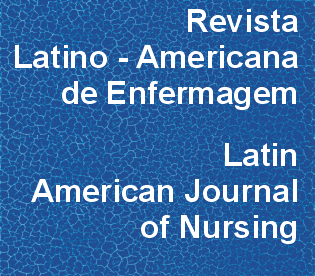Pronto-socorro publico: impactos psicossociais no dominio fisico da qualidade de vida de profissionais de enfermagem
DOI:
https://doi.org/10.1590/0104-1169.3171.2387Resumo
OBJETIVOS: determinar os principais fatores psicossociais do trabalho, relacionados a prejuízos no domínio físico de qualidade de vida de profissionais de enfermagem, em um pronto-socorro público. MÉTODOS: estudo transversal, descritivo, com a participação de 189 profissionais de enfermagem. Utilizou-se a Job Stress Scale e a versão abreviada do instrumento para avaliação de qualidade de vida da Organização Mundial da Saúde, para a coleta de dados, e o Modelo Demanda-Controle de Robert Karasek como referencial para análise da configuração psicossocial. Calcularam-se o risco para prejuízos e o intervalo de confiabilidade de 95%. RESULTADOS: em relação ao ambiente psicossocial, a maior proporção de trabalhadores apresentou vivência de baixas demandas psicológicas (66,1%) e baixo suporte social (52,4%), além de 60,9% dos profissionais serem categorizados vivenciando as situações de trabalho com maior potencial patologizante: trabalho de alta exigência (22,8%) e trabalho passivo (38,1%). CONCLUSÕES: baixo discernimento intelectual, baixo suporte social e vivenciar um trabalho de alta exigência ou trabalho passivo foram os principais fatores de risco para prejuízos no domínio físico de qualidade de vida.Downloads
Downloads
Publicado
2014-01-01
Edição
Seção
Artigos Originais
Licença
Os direitos autorais são de propriedade exclusiva da revista, transferidos por meio da Declaração de Transferência de Direitos Autorais (presente no Formulário Individual de Declarações) assinada pelos autores. Para a utilização dos artigos, a RLAE adota a Licença Creative Commons, CC BY-NC Atribuição não comercial (resumo ou código completo da licença). Com essa licença é permitido acessar, baixar (download), copiar, imprimir, compartilhar, reutilizar e distribuir os artigos, desde que para uso não comercial e com a citação da fonte, conferindo os devidos créditos autorais a Revista Latino-Americana de Enfermagem. Nesses casos, nenhuma permissão é necessária por parte dos autores ou dos editores.Como Citar
Pronto-socorro publico: impactos psicossociais no dominio fisico da qualidade de vida de profissionais de enfermagem . (2014). Revista Latino-Americana De Enfermagem, 22(1), 51-58. https://doi.org/10.1590/0104-1169.3171.2387



